How to use the SUMIF function in Excel
Introduce
The SUMIF function is a function used to sum values in a specified range. The SUMIF function can be used for summing cells based on the date, data and text that are connected to the specified area. This function supports logical operations (>, <, <>, =) and symbols (*,?) To suit each section.

Purpose
Sum the numbers in the range that meet the criteria provided.
Search for value
Total value provided.
Syntax
= SUMIF (range, criteria, [sum_range])
Parameters
Range : Range of cells you want to evaluate according to criteria. The cells in each range must be numbers or names, arrays or references containing numbers. Empty values and text values are ignored. The selected range may contain dates in the standard Excel format.
Criteria : Criteria for determining added values.
Sum_range : (optional) Values are appended. If sum_range is removed, the cells in the scope of the evaluation will be replaced.
Attention
- When sum_range is ignored, cells in the range will be added.
- A defined area containing mathematical symbols or symbols must be enclosed in quotation marks.
- The range of numeric format that can be supplied is the number that will not have to use parentheses.
- The characters?and * can all be used in Criteria.A question mark matches any single character;an asterisk matches any character string.If you want to find a real question mark or asterisk, type the tilde (~) before the character.
How to use SUMIF in Excel
Let's explore the SUMIF calculation.
Suppose we have the following revenue table:
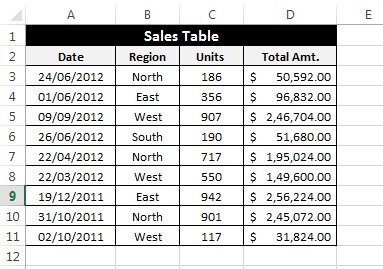
Exercise : To find the total revenue of the northern region.
Try applying the SUMIF function to solve the problem.
Range : Select the column containing "North"
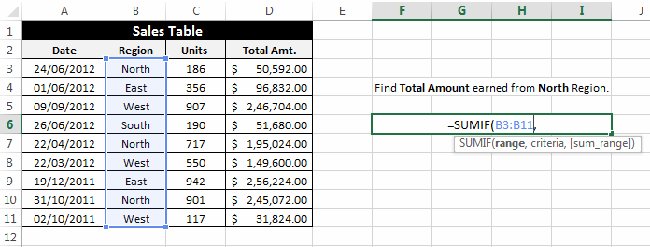
Criteria : Enter the "North" area - North. Note: Entering "North" or "= North" is fine.
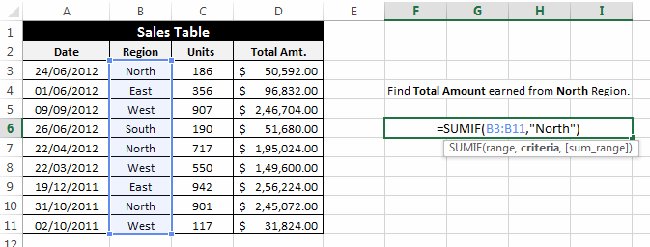
Sum_range : Select the column to be added after evaluating the criteria.
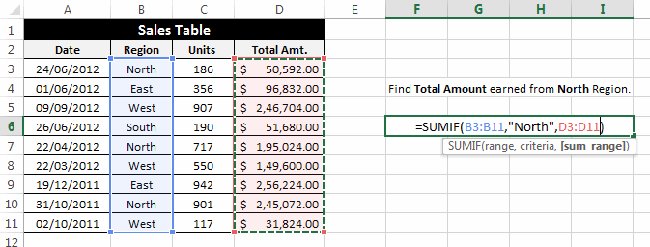
After applying this calculation, our results are 490688, the sum of D3, D7, D10.
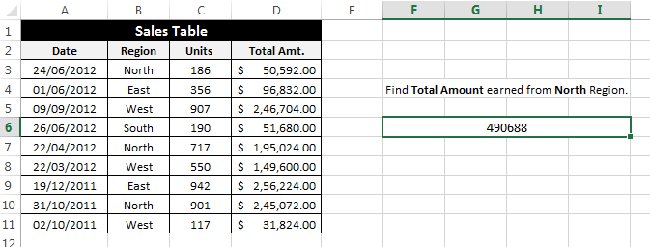
A few examples of SUMIF
Example 1: Suppose there is a table as follows and we need to find the total quantity sold in the Eastern region.

To find the result, we need to apply the calculation: = SUMIF (B3: B11, "East", C3: C11)
And the calculation result is 129.
Example 2: In the same revenue table, write the formula to calculate the total amount before the "January 1, 2013".

In this case, we use the calculation: = SUMIF (A3: A11, "
Example 3: In this example, we have a list of items by some schools participating in regional events. The task is to find the total number of C medals achieved in events.
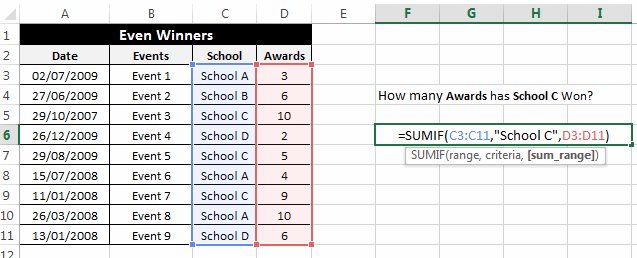
We use calculation = SUMIF (C3: C11, "School C", D3: D11)
And yes D5 + D7 + D9 has results 24.
You should read it
- SUMIF and SUMIFS functions - specific usage and examples
- Sumif and Sumifs functions in Excel
- Differentiate between SUM, SUMIF, SUMIFS and DSUM functions
- The SUM function (sums) in Excel
- How to calculate the total value based on multiple conditions in Excel
- How to use the SUM function to calculate totals in Excel
- OR function in Excel, how to use the OR function, and examples
- Basic Excel functions that anyone must know
May be interested
- How to use the SUM function to calculate totals in Excel
 sum is a popular and very useful excel function, and is also a basic arithmetic function. as its name suggests, the sum function is used to calculate totals in excel. and the parameters can be single parameters or ranges of cells. in this article, tipsmake.com will guide you to use the sum function to calculate the sum in excel, the common errors when calculating sum by sum and how to fix it.
sum is a popular and very useful excel function, and is also a basic arithmetic function. as its name suggests, the sum function is used to calculate totals in excel. and the parameters can be single parameters or ranges of cells. in this article, tipsmake.com will guide you to use the sum function to calculate the sum in excel, the common errors when calculating sum by sum and how to fix it. - DATE Function: Converts numbers to a valid date format
 the date function in excel is a useful and most commonly used function. let's learn how to use the date function in excel with tipsmake.com.com!
the date function in excel is a useful and most commonly used function. let's learn how to use the date function in excel with tipsmake.com.com! - How to use the LEN function in Excel
 the len function in excel is used to measure the length of a certain string of characters, including spaces and correctly return the total character for the user.
the len function in excel is used to measure the length of a certain string of characters, including spaces and correctly return the total character for the user. - How to use COUNTIF function on Excel
 the countif function on excel is the cell count function to satisfy the given condition, often used in statistics tables.
the countif function on excel is the cell count function to satisfy the given condition, often used in statistics tables. - How to use the MOD function and QUOTIENT function in Excel
 injury in excel has many ways of doing it, can be used manually or using the calculation function.
injury in excel has many ways of doing it, can be used manually or using the calculation function. - 8 little-known Excel functions that can save you a lot of work
 even seasoned excel users often find themselves stuck performing tasks manually that could be automated with a few clever functions.
even seasoned excel users often find themselves stuck performing tasks manually that could be automated with a few clever functions. - How to use MID functions to get strings in Excel
 mid function in excel is a function that takes the middle character string corresponding to the value that the user requires to perform.
mid function in excel is a function that takes the middle character string corresponding to the value that the user requires to perform. - How to use Excel's VALUE function
 excel's value function will convert a string to a digital form, which can be combined with other functions such as left function, right function, mid function.
excel's value function will convert a string to a digital form, which can be combined with other functions such as left function, right function, mid function. - How to use the WRAPROWS function in Excel
 having trouble with handling large data sets in excel? then learn how to use the wraprows function to split them into more manageable rows.
having trouble with handling large data sets in excel? then learn how to use the wraprows function to split them into more manageable rows. - How to use the IFS function in Excel 2016
 the ifs function in excel is a logical function introduced in excel 2016. this function is a function that replaces the nested if function and is much easier to use. the ifs function checks one or more conditions and returns a value that meets the first true condition.
the ifs function in excel is a logical function introduced in excel 2016. this function is a function that replaces the nested if function and is much easier to use. the ifs function checks one or more conditions and returns a value that meets the first true condition.










 How to turn off the Start interface on Word 2016
How to turn off the Start interface on Word 2016 Create automatic table of contents in Word 2003
Create automatic table of contents in Word 2003 Create automatic table of contents in Word for Word 2007, Word 2010 to Word 2019
Create automatic table of contents in Word for Word 2007, Word 2010 to Word 2019 How to convert JPG image file to PDF file online
How to convert JPG image file to PDF file online Create a list of tables in Word automatically
Create a list of tables in Word automatically How to convert PDF files to doc or docx files with Zamzar online
How to convert PDF files to doc or docx files with Zamzar online